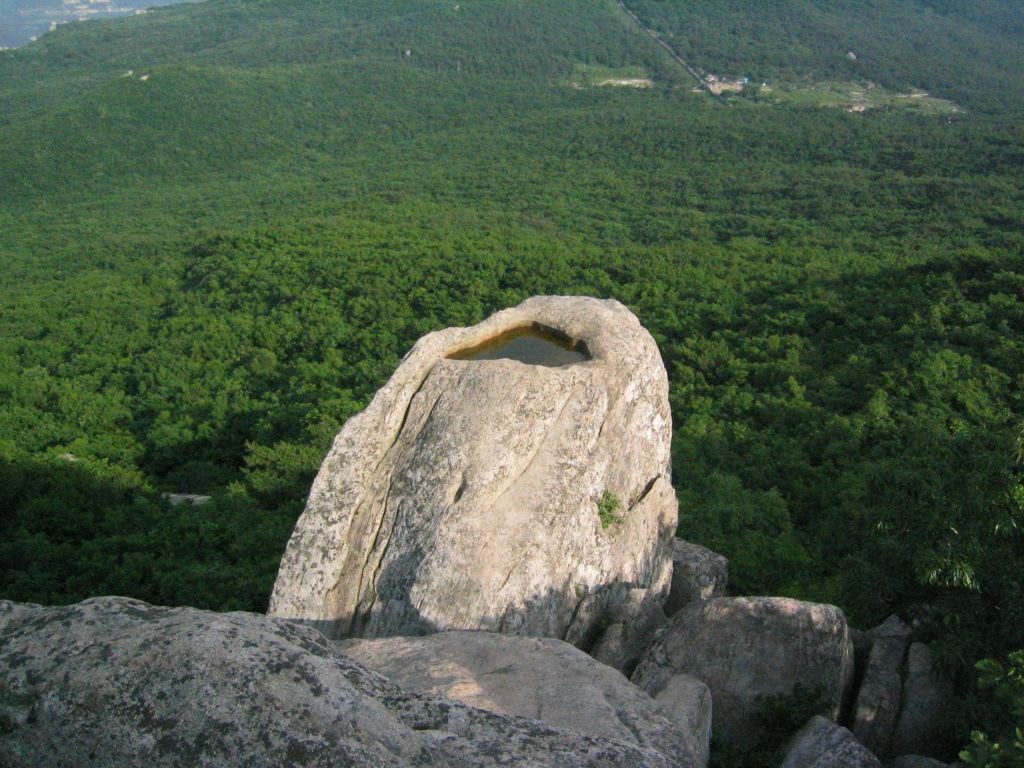- Geumjeongsan
Infobox Korean name
hangul=금정산
hanja=linktext|金|井|山
rr=Geumjeongsan
mr=Kǔmjǒngsan|Geumjeongsan (or Geumjeong Mountain) is a mountain in the city of
Busan inSouth Korea . It covers a large surface that extends intoDongnae-gu in the south, Buk-gu in the west,Geumjeong-gu in the east, and the city ofYangsan in the north. Its highest peak, Godang-bong, the highest peak in the region, stands at 801.5 meters on the city limit between Busan and Yangsan.Geumjeongsan is the city's most popular hiking destination, and thousands of people climb it during the week-ends. The top can easily be reached using the cable-car in Geumgang Park near Myeongnyundong station or by taking the bus from Oncheonjang station to "Saseongmaeul" on the mountain top.
Sanseongmaeul (산성마을) is a small rural community built in the mountain valley, isolated from the surrounding city. It includes a few agricultural fields and livestock pastures on the valley sides. The place is well-known for its speciality meal: "barbecued goat meat".
Geumjeongsan is renowned for the Geumjeongsanseong built on top of the mountain and Beomeo Temple on its north-east side.
Geumjeongsanseong (Fortress)
Infobox Korean name
title=Geumjeongsanseong
|caption=West Gate of the Geumjeongsanseong.
hangul=금정산성
hanja=金井山城
rr=Geumjeongsanseong
mr=Kǔmjǒngsansǒng|Following the Japanese invasion of 1592 and the
Manchu invasion in 1627 and again in 1637 the construction of theGeumjeongsanseong fortress was recommended by the governor of Gyeongsang-do. The construction of fortress itself was started in1701 and finished in1703 , the 29th year of the reign of King Sukjong. The construction of the walls was completed in1707 They are about 17 km in length and 1.5 to 3 meters in height. They circle a surface of about 8.2 km². The fortress eventually fell due disuse due to its high maintenance cost until it was restored in1807 , the 7th year of the reign of King Sunjo. The West Gate was built that year and the other gates during the following year.Today, thanks to the restoration efforts, much of the walls and the four gates still stand. Of the 4 existing observation towers, the tower number 1 (제1망루) located on the south-west side was destroyed by the typhoon Rusa on the morning of September 1, 2002. [cite news|title=문화재 금정산성 제1망루 태풍에 파손|url=http://news.naver.com/news/read.php?mode=LSD&office_id=001&article_id=0000230798§ion_id=102&menu_id=102|date=2002-09-01|accessdate=2007-09-11|publisher=Yonhap News Agency|language=Korean] The area around the South Gate is a popular resting place. The West Gate, even though it is the most impressive of the four, is the less frequented one due to its lack of accessibility.
Restoration work
Since much of the fortress had been destroyed during the Japanese occupation (1910-1945), restoration work was started in
1972 . In1974 The East, West and South Gates were restored and the North Gate was rebuilt in1989 .More restoration works, commissioned by the Busan City Council, are currently under way. This restoration is taking place over a period of 15 years and is divided in 3 phases of 5 years between
1996 and2010 .
*Phase 1 (1996-2000) covers the west region, going from the North Gate down to the West Gate.
*Phase 2 (2000-2005) covers the section of wall on the east side, running between the North Gate and the East Gate. It include the obsrevation towers 3 and 4.
*Phase 3 (2006-2010) covers everything south of the West and East Gates, including the South Gate and the observation towers 1 and 2.Godangbong
Infobox Korean name
title=Godangbong
|caption=Godang-bong
hangul=고당봉
hanja=linktext|姑|堂|峰
rr=Godang-bong
mr=Kodang-bong|Godangbong is the highest peak on the mountain. It stands at an altitude of 801.5 meters on the city limit between
Busan andYangsan . Its summit gives a great view of the surroundings, includingGimhae International Airport in Gangseo-gu. On very clear days it is possible to see the cities ofGimhae andJinhae further to the south-west and the mountain relief ofTsushima Island half-way in theKorea Strait .Geumsaem
Infobox Korean name
title=Geumsaem
|caption=Geumsaem; the North Gate can be seen far in the distance.
hangul=금샘
hanja=linktext|金|井
rr=Geumsaem
mr=Kǔmsaem|Geumseam (literally "Golden fountain") is a naturally formed cavity on top of a granite boulder standing off a cliff about 500 meters east of Godang-bong.
According to the legend a golden fish ("Geumeo", 그머) came down from the world of Brahma on a 5-coloured cloud and took residence in the golden fountain. The fountain if said to never dry and the colour of its water is always gold. The names of the mountain and Beomeo temple originated from that legend.
Today the legend is still represented in the symbols of
Geumjeong-gu . The "gu's" logo represent the fountain and the "gu's" character is a cartoon representation of "Geumeo". [http://geumjeong.go.kr/eng/d/d01.html]ee also
*
List of mountains in Korea References and external links
*On-site Stelae
* [http://geumjeong.go.kr/eng Geumjeong-gu] website
*http://www.orientalarchitecture.com/pusan/geumjeongsanindex.htm
Wikimedia Foundation. 2010.
